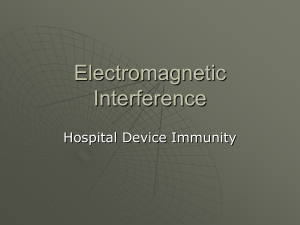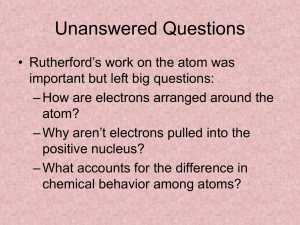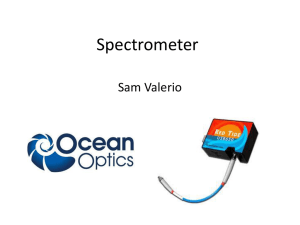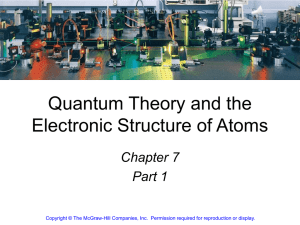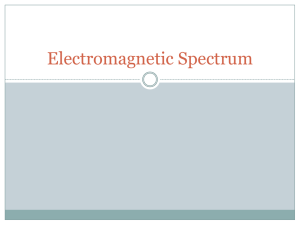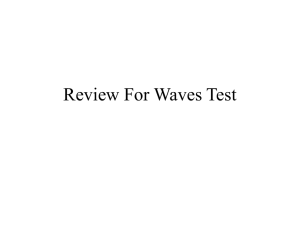Presentation - Department of Physics & Astronomy
advertisement
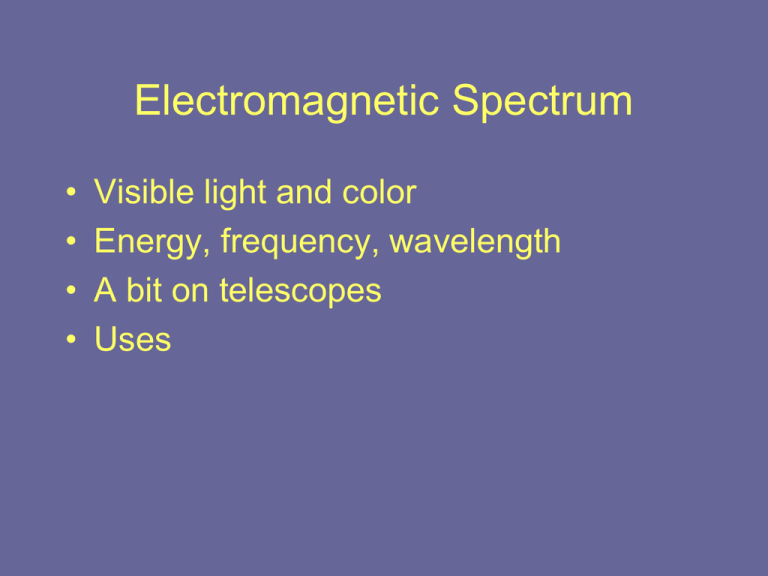
Electromagnetic Spectrum • • • • Visible light and color Energy, frequency, wavelength A bit on telescopes Uses Why do we care about light? • Everything we know in astronomy comes from light • We only have physical samples from the Moon, Mars, and a couple comets – Even these we study using light Electromagnetic Radiation • Radiation: when things are sent out into empty space • EM radiation: light • Nuclear radiation: result of nuclear reactions, includes – Alpha particles (Helium nucleii) – Beta particles (positrons = anti-matter electrons) – Gamma “particles” (gamma EM radiation) What is Light? • Electric and magnetic fields waving • Packets of energy called photons • Energy and wavelength determine what the light can interact with http://www.yorku.ca/eye/spectrum.gif False Color Images • Pictures attempt to “translate” invisible light to what we can see. • Representative color – colors have meaning, such as specific non-visible colors or chemicals • “Touch the Universe” by Noreen Grice High Energy High Frequency Short Wavelength High Energy High Frequency Short Wavelength • Interacts with small things (cells, molecules, DNA) • Created by high energy / hot processes http://upload.wikimedia.org/wikipedia/commons/9/99/EM_Spectrum3-new.jpg ϒ-ray (gamma) and X-ray • High energy, short wavelengths • On Earth: radioactivity, some cancer treatment, broken bones, cavities • Astronomy: high energy processes, hot environments, colliding stars, around black holes, gas around galaxies, the Sun http://today.slac.stanford.edu/images/2007/swiftgamma-ray-lg.jpg http://www.atnf.csiro.au/people/mdahlem/img/xmm tel.gif Ultraviolet (UV) • Slightly higher frequencies and shorter wavelengths than humans can see • Some birds and insects can see in the UV • On Earth: suntans, sunburn, cancer, can be used to sterilize equipment • Astronomy: Used to study the Sun and other hot objects http://sohowww.nascom.nasa.gov/data/realtime/eit _195/1024/latest.html – Hubble is mostly visible, but does have one UV instrument Visible light and color • A small part of the total spectrum • Approximately 400-700nm, 40007000Å, violet to red • Each color the eye can see has a different wavelength. http://solarsystem.nasa.gov/deepimpact/images/Spect-Prism-sm.jpg Why do our eyes see with Visible light? Atmospheric Windows Wavelength, Energy Frequency Need satellites to observe High flying air planes or satellites Why do our eyes see with Visible light? • Atmospheric windows – Visible and Radio get through an Earth-like atmosphere • Wavelength determines size of things it can interact with – Due to evolution, sizes of our eyes, sizes of molecules in our eyes, we see visible light Low Energy Low Frequency Long Wavelength Low Energy Low Frequency Long Wavelength • Interact with larger things • Lower energy processes http://upload.wikimedia.org/wikipedia/commons/9/99/EM_Spectrum3-new.jpg Infrared (IR) • Slightly longer wavelength and lower frequency than the human eye can see. • Some animals including some snakes, some bats, and some insects can see IR. • On Earth: IR goggles help firefighters, soldiers, and home insulation experts; TV remote controls, Kinect • Astronomy: IR travels through dust so is good to look at young forming stars. (e.g., James Webb Space Telescope, HST’s successor) http://upload.wikimedia.org/wikipedia/en/c/cf/Ir_gir l.png Microwave/Sub-mm/Radio • Low energy, long wavelength • On Earth: microwave ovens, cellphone signals, radio for stereos, (formerly) TV broadcasts, GPS, walkytalkies, satellite communications, GPS, weather radar, radar guns • Astronomy: cool objects such as clouds of dust, gas clouds, entire galaxies, SETI, Cosmic Microwave Background (light from the Big Bang) http://apod.nasa.gov/apod/image/0302/sky_wmap_big.j pg http://cache.eb.com/eb/image?id=96170&rendTypeId=4 Bad Science: “Listening” to Radio Like all types of light, radio light is studied using either images or spectra (graphs of the “colors” – brightness at each Nancay Radio Telescope http://upload.wikimedia.org/wikipedia/commons/9/99/EM_Spectrum3-new.jpg Each part of the wavelength tells us part of the story. Must put together all wavelengths to get the full story. http://www.thunderbolts.info/tpod/2006/image06/060123 Example: The Sun • http://sohowww.nascom.nasa.gov/data/realti me/realtime-update.html • Putting these together helps us understand the layers of our dynamic Sun.




